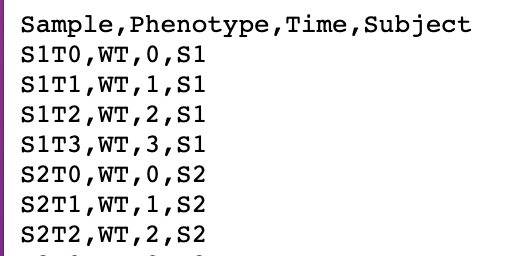Hi there,
I have an experimental design with 2 factors (concentration and time) with repeated measures (i.e. the same subject is tested for each combination of factors).
I have tried the 2way ANOVA analysis after uploading my data as time series + one factor and I click to include the interaction term that says it is repeated measures but I don’t see anywhere to input what column to repeat by. Is it automatically blocking (or doing the repeated measures) on the Subject column in the metadata? Or is the term “repeated measures” used differently here?
Also, when I upload my data like this, many proteins are significant to concentration (main factor) and the interaction, but time comes up as 0. Is this something that happens due to the nature of the time series data format? Or perhaps it is true that none change with time in my analysis. When I upload the data as multivariate and put time as a different categorical factor, only 3 come up as significant under time while the other factor and interaction are 0. So now I am wondering what the difference is in analysis when I upload the same data but in different formats.
I’ve also tried the limma analysis but I don’t think that Time counts as a covariate and so there doesn’t seem to be a way to include the two factors.
Thank you for the help and advice!
Sarah
Hi Sarah,
In the “Statistical analysis [metadata table]” module, there is an experimental design called “Time series + 1 factor” that sounds appropriate for your data. If you scroll down to the example data on the upload page and click the link for metadata on the third example, you can see the required format (must use these column names):

If you format in this way, subject will automatically be considered as a repeated measure. Note that the underlaying R package requires a balanced design (same # replicates per experimental group).
Another option is the “Multiple factors/covariates” option. Here, make sure time is a continuous variable on the metadata check page. Then, select “Linear models with covariate adjustment”. Specify ‘Subject’ as a blocking factor (this models as a random effect - appropriate for repeated measures on the same person). Now you can view metabolites associated with ‘Time’ by putting time as primary and ‘Treatment’ as secondary, or metabolites associated with ‘Treatment’ by switching them. This is fitting a regression model to the data, then pulling out the coefficients associated with either ‘Time’ or ‘Treatment’ (depending on what is designated primary), while controlling for the effects of the other variables.
Hopefully this helps, statistical designs start getting complicated with more metadata!
1 Like
Thank you @jess.ewald for the confirmation for the repeated measures!
Hi,
I’d also like to know if I the time series + 1 factor is appropriate to use? But I get an error about missing sample names when I upload. For each genotype I have 2 reps, 2 years of data and then a phenotype whether it was raw or roasted. So I followed the format below. When I did the statistical analysis 1 factor I had to combine factors in the name to have only 1 name- no duplicate names, so I didn’t think that analysis was appropriate.
Sample, Phenotype, Time, Subject
10_7.2019, Raw, 2019, 10_7
10_7.2019, Raw, 2019, 10_7
10_7.2019, Roasted, 2019, 10_7
10_7.2019, Roasted, 2019,10_7
10_7.2020, Raw, 2020, 10_7
10_7.2020, Raw, 2020, 10_7
10_7.2020, Roasted, 2020, 10_7
10_7.2020, Roasted, 2020, 10_7
Thank you!
Gina
